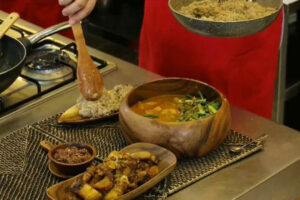Learning about Cavite cuisine through the Tres Marias

CULINARY historian and writer Ige Ramos, along with local Cavite restaurateur Agnes Bautista-Poblete of Cantina de Tita A shared a bit about their hometown via a cooking demonstration last week. This is part of the ongoing Philippine Food Tour series of The Maya Kitchen, streamed monthly on Facebook.
For this particular demo, Ms. Poblete made a Caviteño triple-treat called the Tres Marias (Three Marias). This consists of Kare-kare (a tripe stew with a peanut-based sauce), Adobo Seca (a dry adobo which is usually meat cooked in vinegar), and Kilawing Papaya. Of the combination’s unusual name, Ms. Poblete said: “Hindi naman talaga malinaw ang paliwanag sa akin. Ang sabi lang nila, kasi noong panahon ng Kastila, ang mga tumutulong sa kusina ay mga Pilipina (It wasn’t clearly explained to me. What they said was that during the Spanish Occupation, the kitchen helpers were the Filipinas).” So, according to her, those Filipinas were ordered to do this and that, perhaps being addressed by their names.
Anyway, she says that these dishes are usually served during special Sunday luncheons, cooked at the same time so they’d be ready to serve at tables.
THE FIRST MARIA: KARE-KARE
The kare-kare was made first, featuring tripe and beef cheeks. Mr. Ramos pointed out that in Cavite, tripe is called mindongo (as opposed to other regions calling it tuwalya, due to its resemblance to terrycloth towels). The rest of the ingredients included garlic, onions, string beans, banana hearts, pechay (Chinese cabbage), annatto (locally known as atsuete), ground peanuts, and ground rice.
Normally, Mr. Ramos says, kare-kare is cooked over six hours, but because of TV magic (namely, that they had simmered the tripe and the cheeks beforehand), they managed to cut the cooking time to under an hour. He advised viewers to throw out the initial stock (due to it being tainted by smells and scum), then to keep the water from the second boiling to use as stock. Ms. Poblete, meanwhile, chopped the banana hearts thinly: it’s less regional but more personal history: she used to do this so her children would find it easier to eat.
She said that normally, this would be cooked in a big kawali (a big native pan, a bit like a wok), over a wood fire. Garlic and onion were sauteed, to which the meats were added. In another pan, the vegetables were sauteed simultaneously, with Mr. Ramos pointing out that the banana hearts had to be added to the pan first, due to the presence of cellulose fiber that makes the vegetable hard. In another pan, the annatto water was added to the meats. Mr. Ramos said that he sometimes uses lye to brighten the color of the annatto, to make it a deeper red. Once the meats were boiling, that was when they added the ground peanut, suspended in water. He said to make sure to mix the peanut well: the proteins present in peanuts make them impossible to completely dissolve, and they tend to stick to the bottom of the pan. To flavor and to thicken the sauce, toasted ground rice was added.
In some other households, the vegetables aren’t sauteed, but are added to the peanut soup to stew alongside the meat. In Cavite, according to them, the sauteed vegetables are served separately. Mr. Ramos notes that kare-kare is a difficult dish to make, due to it having to be cooked in two different pans.
He also noted that when looked at through different lenses, it would appear that our cooking overcooks its vegetables. He explained, “In reality, the reason why we overcook our vegetables is because our vegetables are very hard.” Jumping to another region, he said that in Ilocos, pinakbet (a dish made with assorted vegetables in fish paste or sauce), is cooked until the vegetables are wrinkly (which is the source of its name, from another Ilocano word describing that appearance). This, he says, is when those vegetables release their flavor.
THE SECOND MARIA: ADOBO SECA
Next, they jumped over to Adobo Seca, which is taken from a Spanish word meaning dry (seca). This was made with your normal adobo ingredients (pork, garlic, bay leaves, and vinegar), but omitting the soy sauce (a fairly recent, but mainstream addition), and adding annatto to the mix. The annatto, Mr. Ramos pointed out, was an import to the Philippines from Mexico via the galleon trade.
The pork was browned in oil, and its fat was allowed to render, after which garlic was added. As the oil sizzled, Mr. Ramos said, “Ito iyong sound na gustong-gusto ko (this is the sound that I really like).”
Both cooks had opinions on why Cavite cuisine is so. Ms. Poblete said, “Siguro iyong panlasa na meron ang mga Caviteño (Maybe it’s the taste that Caviteños have).” Mr. Ramos agrees, noting that Cavite cuisine isn’t known for extremes, like dishes being too sweet, too rich, or too spicy.
On a funnier note, as the fumes of the garlic reached his nose, Mr. Ramos said, “Kaya walang aswang sa Cavite. Grabe kami gumamit ng bawang (This is why we don’t have monsters in Cavite. We use too much garlic),” alluding to the old legend that garlic repels monsters like vampires and other ghouls. Speaking of old wives’ tales, Mr. Ramos addressed one about adobo. As they were cooking, vinegar was one of the last ingredients to be added, and tradition says that one shouldn’t stir adobo until after the vinegar has been thoroughly cooked. “Wait for it to simmer,” he said, giving this old wives’ admonition a new stamp of approval.
THE THIRD MARIA: KILAWING PAPAYAFinally, the dish ended with a kilawing papaya. Normally, kinilaw is raw fish cooked in vinegar, but in Cavite, this is a dish made with grated green papaya, garlic, miso, vinegar, and a little-used ingredient: beef pancreas. This was cooked in a pan, over a fire.
“Ito, favorite ko ito (This is my favorite). Every time I go home to Cavite, I always crave for kinilaw. That’s why I always visit Tita A’s Cantina. She makes a really good kinilaw. This is like a childhood memory for me,” said Mr. Ramos.
“When you talk about Cavite food, [it’s like], ‘What? Is there such a thing as Cavite food?’”
Mr. Ramos has been known to promote Cavite cuisine as an especially historical one, noting the region’s long history, particularly as the food of the birthplace of modern Filipino democracy. In jest, he noted that the region is better known for its amulets, the action films of actor and politician Ramon Revilla, and criminals like Nardong Putik. “Very notorious kami,” he said. — Joseph L. Garcia




